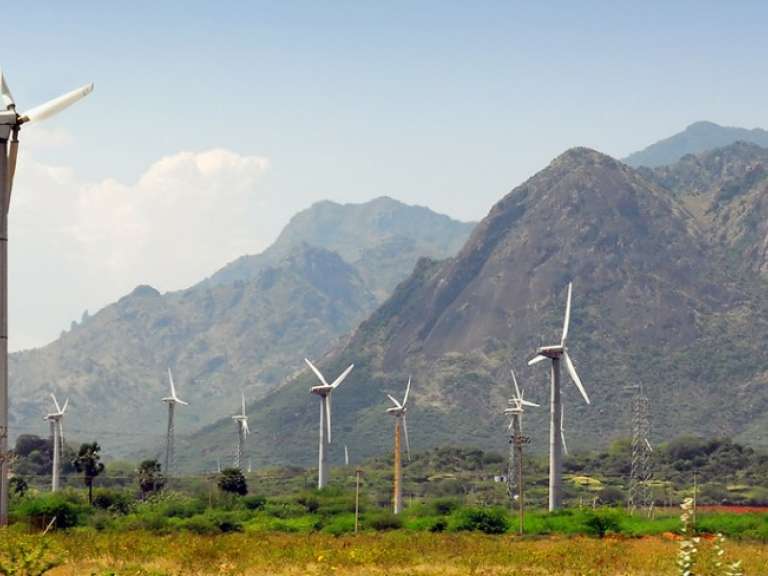India is one of the world's most important energy consumers. As such, continued development of renewable energy in India is critical for a global community seeking to limit carbon dioxide emissions. However, there are some fears that, should U.S. commitment to clean power falter under the Trump administration, the resolve of developing countries will weaken as a result.
The Paris Accord
In December 2015, representatives of 195 countries met in Paris and agreed to a treaty to limit the rise of global carbon dioxide emissions. The Intergovernmental Panel on Climate Change (IPCC) has warned that to keep the global temperature increase to less than 2°C by the year 2100, the atmospheric CO2 equivalent concentration has to be limited to 450 parts per million (ppm). Beyond this level, scientists warn of dangerous effects of climate change.
The Paris Agreement is the world's first comprehensive climate agreement. According to the United Nations, it seeks to achieve "global peaking of greenhouse gas emissions as soon as possible." The world's three largest emitters of carbon dioxide—China, the United States, and India—all signed the agreement on April 22, 2016.
India's Clean Power Plan
India's climate pledge for the Paris Agreement was that the country will follow "a cleaner path than the one followed hitherto by others at a corresponding level of economic development," according to the United Nations in India. To achieve this, India has established goals to rapidly expand its use of renewable energy and more efficient technologies.
Renewable energy in India is poised to thrive. According to The Economic Times, India has set targets of adding 175 gigawatts (GW) of renewable energy capacity by 2022, including 100 GW from solar, 60 GW from wind, 10 GW from biopower, and 5 GW from small hydropower. In addition, larger hydropower projects could push the total to 225 GW by 2022.
This is an especially ambitious target for solar power in India. According to the BP Statistical Review of World Energy, India had 880 megawatts (MW) of installed capacity in 2015. While this was more than 10 times the 70 MW that was installed in 2010, it will require an acceleration in the deployment of solar capacity in India.
The target for wind power is more conservative. To achieve 60 GW of wind capacity will only require a little over double 2015's 25 GW of installed capacity, according to BP. That, in turn, represents just under double the capacity from 2010's 13 GW of installed wind capacity.
Developing Versus Developed Countries
There has always been tension between the world's developed and developing countries regarding action on limiting carbon dioxide emissions. The argument is that cheap energy sources like coal played an important role in the development of countries like the U.S., which, in fact, is responsible for a larger share of legacy carbon dioxide emissions than any other country. Thus, developing countries sometimes take the position that they shouldn't be held to the same standards as countries that developed with the assistance of cheap coal. According to this argument, the developed countries have a larger responsibility to take the lead on climate change, given their historical emissions.
A comparison of the emissions of China, India, and the U.S. demonstrates the dilemma. India and China, both with populations over one billion, have significantly lower per capita emissions than the U.S. That's largely a function of the level of development of these populations, but according to the World Bank, both the populations and the per capita emissions of India and China are increasing.
These trends have important ramifications for global climate policies. The BP Statistical Review shows that China surpassed the U.S. in overall carbon dioxide emissions in 2006, and they have increased emissions by nearly 40 percent since. India's carbon footprint is growing even faster than China's. In the past 10 years, India's carbon dioxide emissions have increased by 83 percent, and they have increased 37 years in a row.
The primary culprit in India is coal consumption, which has nearly doubled in the past 10 years, according to BP. In fact, in 2015, India's coal consumption surpassed that of the U.S. If current trends continue, India's carbon dioxide emissions will surpass those of the U.S. in the next decade.
The International Energy Agency's (IEA) 2016 World Energy Outlook projects that India's coal consumption is set to grow more than any other country's. The IEA predicts that it will more than double again by 2035 even if India follows through on the climate change promises it made as a result of the Paris Agreement. India is also likely to become the largest source of demand growth for oil with a 6 million barrel-per-day (bpd) projected increase. This makes India's commitment to clean power critical in the years ahead.
Looking Ahead
India's renewable energy minister, Piyush Goyal, has vowed that his country will not deviate from its clean energy targets, regardless of President Donald Trump's policies, according to PEI. However, India faces the challenge of bringing power to 300 million people without access to electricity. Historically, countries have done this by relying heavily on fossil fuels. India faces the additional challenge of providing power to its population without a commensurate rise in the country's carbon dioxide emissions. India will need access to clean, affordable power, which will require continued improvements in clean energy technologies.
